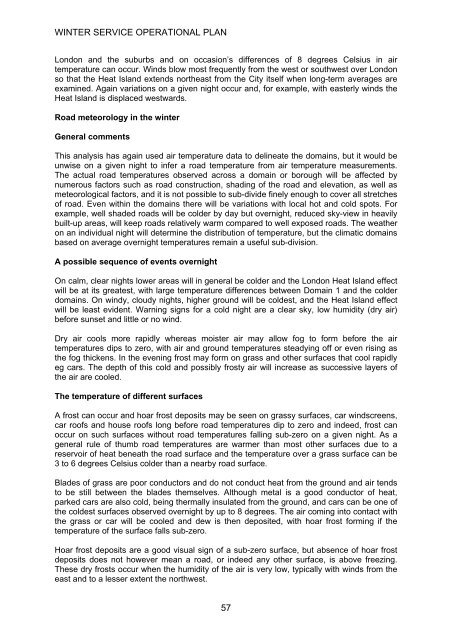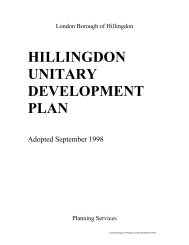Report - London Borough of Hillingdon
Report - London Borough of Hillingdon
Report - London Borough of Hillingdon
You also want an ePaper? Increase the reach of your titles
YUMPU automatically turns print PDFs into web optimized ePapers that Google loves.
WINTER SERVICE OPERATIONAL PLAN<br />
<strong>London</strong> and the suburbs and on occasion’s differences <strong>of</strong> 8 degrees Celsius in air<br />
temperature can occur. Winds blow most frequently from the west or southwest over <strong>London</strong><br />
so that the Heat Island extends northeast from the City itself when long-term averages are<br />
examined. Again variations on a given night occur and, for example, with easterly winds the<br />
Heat Island is displaced westwards.<br />
Road meteorology in the winter<br />
General comments<br />
This analysis has again used air temperature data to delineate the domains, but it would be<br />
unwise on a given night to infer a road temperature from air temperature measurements.<br />
The actual road temperatures observed across a domain or borough will be affected by<br />
numerous factors such as road construction, shading <strong>of</strong> the road and elevation, as well as<br />
meteorological factors, and it is not possible to sub-divide finely enough to cover all stretches<br />
<strong>of</strong> road. Even within the domains there will be variations with local hot and cold spots. For<br />
example, well shaded roads will be colder by day but overnight, reduced sky-view in heavily<br />
built-up areas, will keep roads relatively warm compared to well exposed roads. The weather<br />
on an individual night will determine the distribution <strong>of</strong> temperature, but the climatic domains<br />
based on average overnight temperatures remain a useful sub-division.<br />
A possible sequence <strong>of</strong> events overnight<br />
On calm, clear nights lower areas will in general be colder and the <strong>London</strong> Heat Island effect<br />
will be at its greatest, with large temperature differences between Domain 1 and the colder<br />
domains. On windy, cloudy nights, higher ground will be coldest, and the Heat Island effect<br />
will be least evident. Warning signs for a cold night are a clear sky, low humidity (dry air)<br />
before sunset and little or no wind.<br />
Dry air cools more rapidly whereas moister air may allow fog to form before the air<br />
temperatures dips to zero, with air and ground temperatures steadying <strong>of</strong>f or even rising as<br />
the fog thickens. In the evening frost may form on grass and other surfaces that cool rapidly<br />
eg cars. The depth <strong>of</strong> this cold and possibly frosty air will increase as successive layers <strong>of</strong><br />
the air are cooled.<br />
The temperature <strong>of</strong> different surfaces<br />
A frost can occur and hoar frost deposits may be seen on grassy surfaces, car windscreens,<br />
car ro<strong>of</strong>s and house ro<strong>of</strong>s long before road temperatures dip to zero and indeed, frost can<br />
occur on such surfaces without road temperatures falling sub-zero on a given night. As a<br />
general rule <strong>of</strong> thumb road temperatures are warmer than most other surfaces due to a<br />
reservoir <strong>of</strong> heat beneath the road surface and the temperature over a grass surface can be<br />
3 to 6 degrees Celsius colder than a nearby road surface.<br />
Blades <strong>of</strong> grass are poor conductors and do not conduct heat from the ground and air tends<br />
to be still between the blades themselves. Although metal is a good conductor <strong>of</strong> heat,<br />
parked cars are also cold, being thermally insulated from the ground, and cars can be one <strong>of</strong><br />
the coldest surfaces observed overnight by up to 8 degrees. The air coming into contact with<br />
the grass or car will be cooled and dew is then deposited, with hoar frost forming if the<br />
temperature <strong>of</strong> the surface falls sub-zero.<br />
Hoar frost deposits are a good visual sign <strong>of</strong> a sub-zero surface, but absence <strong>of</strong> hoar frost<br />
deposits does not however mean a road, or indeed any other surface, is above freezing.<br />
These dry frosts occur when the humidity <strong>of</strong> the air is very low, typically with winds from the<br />
east and to a lesser extent the northwest.<br />
57
















